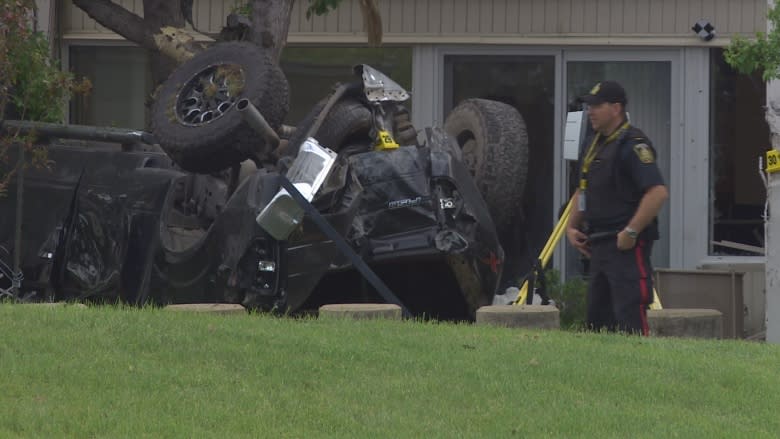Manitoba crashes in 2016 have killed nearly twice as many people as in 2015
A rollover west of Lake Manitoba Monday morning became the sixtieth fatal crash in the province of the year — a mounting total that already almost doubles last year's numbers.
In 2015, 34 people died in 32 crashes in Manitoba according to RCMP, compared to 65 deaths in 60 crashes this year.
The death toll in 2016 is also 20 per cent higher than the five-year average in Manitoba; 55 people have died annually in 48 fatal crashes on average over the past five years, according to RCMP.
These totals also include off-road vehicle crashes. Fifty-one of crashes in 2016 occurred on roads. Nine happened off road, of which two were farm accidents and seven involved ATVs or snowmobiles.
Why the rise?
"It's disappointing this happens sometimes," Sgt. Mark Hume, who has been a collision reconstructionist for about 12 years, told CBC News. "There's anomalies; in some years it goes up, there's no particular reason."
Hume said traffic investigations this year show a few overarching trends: fewer people involved in fatal crashes have worn seatbelts (or helmets in the case of cyclists, motorcyclists or ATV riders) and there's been a rise in fatal impaired driving collisions.
"The impaired driving, it's a trend, it's a social thing. We were making a lot of headway. It seems to this year, a bit of a relapse," Hume said.
Hume said alcohol played a factor in a little over 40 per cent of all fatal crashes in 2016 (26 in total as of Aug. 24), and about half the people who died in crashes were not wearing seatbelts.
"The vast majority of rollovers are survivable if you simply have a seatbelt on, so there's a lot of deaths there that could have been minor injuries if somebody had been buckled up," Hume said.
"It's the small percentage that aren't [wearing seatbelts] who are being killed, so to me that sends even a bigger message. It shows the risk of not wearing a seatbelt is very high."
Speed kills
Another big factor is speed.
Hume said about 50 per cent of all fatal crashes this year involved speeding, but over the past 14 months a new trend has also started to emerge.
The term "super speeder" has been coined to represent motorists who are not only driving beyond the limit, but doing so at excessively fast speeds, and that's something Hume said has been documented more this year.
"My unit patrols the TransCanada Highway from Saskatchewan to Portage la Prairie, and the number of what we call "super speeders" is climbing. I've been in this unit for 10 years. What used to be a once- or twice-a-month super speeder is now once or twice a shift, or once or twice every two or three days," Hume said.
"Recently one of my members caught somebody from out-of-province driving from the East Coast out west going over 170 kilometres an hour with a baby in the car because the baby was crying," he said. "They wanted to get to their destination quicker. That was their excuse."
Other causes
"About 50 percent are speed-related ... 41 percent have alcohol involved. Another 16 per cent are at intersections, so somebody has failed to yield to another vehicle," Hume said. "That adds up to more than 100 per cent, but in some crashes there are two causes."
Nationally, distracted driving accounts for about 10 per cent of fatal rural crashes.
"It's a much bigger number in the urban areas," Hume said, adding it's much harder for investigators to determine if a vehicle crash resulted from distracted driving than when speed or alcohol are involved.
Hume believes too many people take driving for granted and don't pay attention to the rules of the road. He said there is also an element of detachment that allows a lot of people to feel as if "it's not going to happen to them."
"They think drinking and driving is bad but then they just go out and do it. The general attitude is invincibility," Hume said.
"I think the penalties are pretty stiff. What makes a difference is if they see it happen to someone they know. They need to see people who are affected by this."




